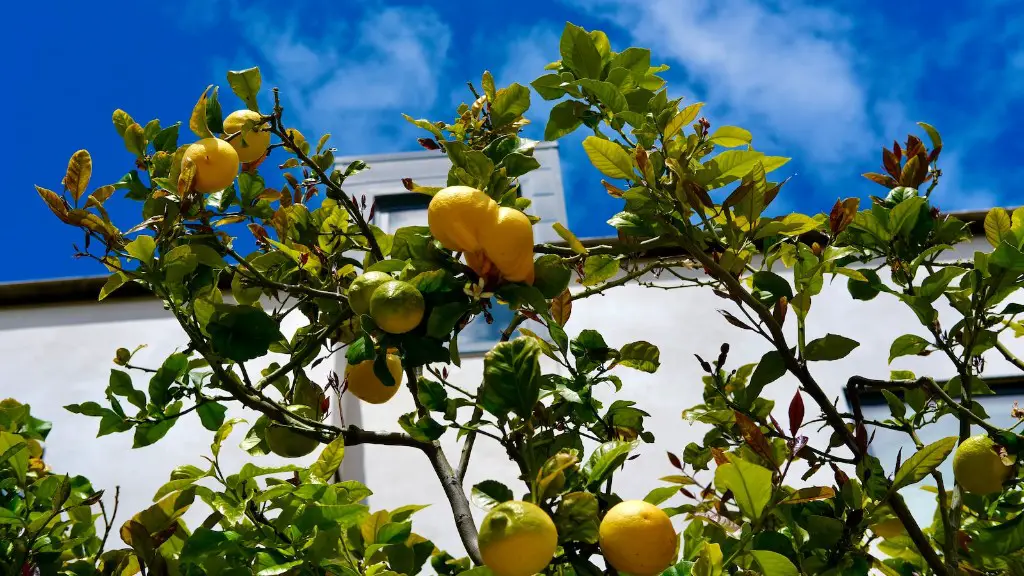Growing a lemon tree is easier than one might expect. With sufficient sunlight and water, anyone can have a successful lemon tree crop within a couple of years. While the growth rate of a lemon tree varies by species, some grow quite fast and can reach mature size quickly. However, there are certain steps one should take for optimal lemon tree growth.
Lemon trees need to be planted in a location that has access to a good amount of sunlight throughout the day. This can be in direct sunlight or even in places where the trees can get at least 6-8 hours of light a day. In addition to that, lemon trees should also get some shade during the day, especially during hot summer days.
When growing lemon trees indoors, it is important to choose a potting soil that is well-draining and rich in nutrients. The soil should also be fertilized regularly in order to provide adequate nutrition to the tree. Furthermore, it is important to keep the soil pH at 6.5 to 7.0, which is slightly acidic. It is also important to protect the lemon tree roots from waterlogging.
In order to obtain the best growth from your lemon tree, it is also necessary to prune it properly and keep it free from pests and diseases. Pruning helps to keep the lemon tree healthy and helps it grow better. At the same time, it is important to keep a regular watch on the tree for any signs of pests or diseases. If any signs are observed, it is important to contact a local nursery or an expert for advice.
With proper care and maintenance, any lemon tree can become a successful grower. It is important to remember that although growing a lemon tree is easy, it still requires dedication and effort to ensure that it is healthy and produces an abundance of sweet, juicy fruits.
Water Requirements
Lemon tree growth requires a moderate amount of water, typically at least an inch of water every week. In hotter climates, they might need more water, up to 4 inches per week in the summertime. Too much water can be damaging, however, as it can lead to root rot and other problems. Additionally, if the tree is planted in soil with poor drainage, the tree can easily suffer from waterlogging.
Although the lemon tree can be irrigated with a sprinkler system or a drip irrigation system, it should be done with caution. In most cases, it is best to water them directly from the soil instead of from a container or from the air. This prevents the tree from being overwhelmed or over watered.
Furthermore, a layer of mulch should be put around the lemon tree in order to help it retain moisture and to prevent weeds from cracking through the soil and competing with the tree for water. Mulch also helps keep the soil cooler, which is important in climates with hot summers.
Finally, the water requirements of the lemon tree may vary depending on the species and the location in which it is planted. When in doubt, it is best to consult a local expert or a gardening book to find out the specific water requirements for a particular species.
Soil Requirements
For optimal growth, lemon trees need to be planted in quality soil that is well-draining and rich in nutrients. As mentioned earlier, the soil should have a slightly acidic pH level of 6.5 to 7.0. The soil should also be well aerated, as this can help promote root development. Additionally, it should be loose and light, as compacted soil can inhibit root development.
A good way to test the quality of soil is to put a handful of it in a jar and add two or three tablespoons of water. Shake it well and let it sit for about 20 minutes. If the water remains clear, the soil is good enough for growing a lemon tree. If it looks murky and the particles settle to the bottom, then the soil is not ideal for growing a lemon tree.
In addition to soil quality, it is also important to make sure the location is suitable for the growth of the tree. It should be away from strong winds and other disturbances, and it should also have access to enough sunlight and some shade. If the tree is being grown indoors, then it should be placed in an area where it can get ample sunlight.
Finally, the soil size should also be suitable for the size of the tree. Lemon trees should be planted in a container that is large enough to accommodate the size of their root system. If the container is too small, it can lead to root rot and other problems, resulting in stunted growth or even death.
Fertilizers
For optimal growth and to ensure that it has enough nutrients to produce fruits, lemon trees should be fertilized on a monthly basis. Organic fertilizers are preferable, as they are less likely to cause harm to the environment. However, chemical fertilizers can also be used as long as they are used according to the instructions on the label.
It is important to remember that fertilizing a lemon tree is not always necessary and it should only be done when the soil is not rich enough in nutrients. Additionally, adding too much fertilizer can be harmful to the tree, so it is best to stick to the recommended amounts on the label or follow a fertilizer schedule provided by a local expert.
It is also important to monitor the lemon tree for signs of nutrient deficiencies, such as yellowing leaves and stunted growth. If any signs are observed, then it is best to adjust the fertilizer schedule accordingly or to contact a local nursery or an expert for advice.
Finally, it is also important to water the tree after fertilizing in order to help the nutrients reach the roots and to prevent the fertilizer from burning the leaves. Additionally, the area around the tree should be clear of weeds, as they can compete with the tree for nutrients.
Pests and Diseases
In order to keep the lemon tree healthy, it is important to keep a regular watch on the tree for any sign of pests and diseases. While there are many types of pests and diseases that can affect lemon trees, some of the most common include caterpillars, aphids, spider mites, and root rot. It is important to take preventive measures to ensure that these pests and diseases do not affect the tree.
An effective way to prevent pests and diseases from affecting the tree is to use organic insecticides and other protective measures. Additionally, it is also important to keep the tree free of weeds, as they can act as hosts for pests and diseases. Furthermore, a layer of organic mulch can help protect the soil from pests and diseases.
If any signs of pests and diseases are observed, then it is important to contact an expert for advice or to use an organic insecticide or fungicide to get rid of the pests or diseases. It is also important to monitor the tree on a regular basis in order to make sure that the pests and diseases do not return.
Finally, it is also important to remember that some types of pests and diseases may require the use of chemical pesticides. In such cases, it is best to consult a local nursery or an expert and to use the products according to the instructions on the label.
Pruning
Pruning is an important step in maintaining the health and shape of a lemon tree. It helps to keep the tree healthy and helps it to produce more fruit. Pruning also helps to reduce the risk of diseases, as it removes any dead, diseased, or damaged branches.
When pruning a lemon tree, it is important to follow the four Ds – dead, diseased, damaged, and crossing branches. These should be removed in order to help the tree grow better and to produce more fruits. It is also important to remember that it is best to prune the tree in late winter or early spring before the new growth begins.
It is also important to remember that pruning is not only part of maintenance, but it is also necessary in order to train the tree and give it a better shape. When pruning, it is best to leave some branches uncut in order to ensure that the tree still has a beautiful shape. Properly trained trees are more likely to produce more fruits, as they are better able to receive sunlight.
Finally, it is important to use the right tools when pruning. Pruning shears should be sharp, as dull shears can damage the branches. Additionally, it is also important to ensure that all the tools are clean before use in order to prevent the spread of diseases.




